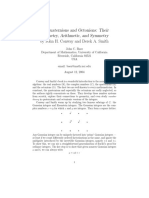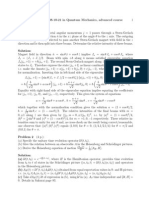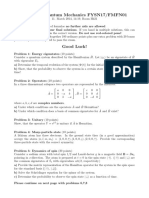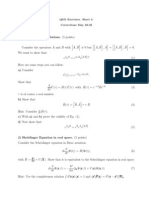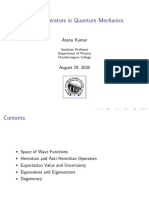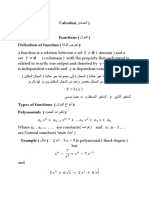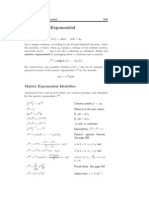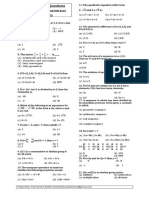Midterm Solution 2017
Midterm Solution 2017
Uploaded by
raja hahaCopyright:
Available Formats
Midterm Solution 2017
Midterm Solution 2017
Uploaded by
raja hahaOriginal Description:
Original Title
Copyright
Available Formats
Share this document
Did you find this document useful?
Is this content inappropriate?
Copyright:
Available Formats
Midterm Solution 2017
Midterm Solution 2017
Uploaded by
raja hahaCopyright:
Available Formats
Advanced Quantum Mechanics: Fall 2017
Solution to Midterm Exam
NOTE: Problems start on page 2. Answer the questions in italic fonts.
Possibly useful facts:
0 1 0 −i 1 0
• Pauli matrices: σ0 = 12×2 , σ1 = , σ2 = , σ3 = .
1 0 i 0 0 −1
σ1 σ2 = iσ3 = −σ2 σ1 , σ2 σ3 = iσ1 = −σ3 σ2 , σ3 σ1 = iσ2 = −σ1 σ3 , σ12 = σ22 = σ33 = σ0 .
So σ1,2,3 mutually anti-commute, {σ1 , σ2 } = {σ2 , σ3 } = {σ3 , σ1 } = 0,
and [σ1 , σ2 ] = 2iσ3 , [σ2 , σ3 ] = 2iσ1 , [σ3 , σ1 ] = 2iσ2 .
• Some Taylor expansions:
xn n x2n+1 n x2n
exp(x) = +∞
P P+∞ P+∞
n=0 n! , sin(x) = n=0 (−1) (2n+1)!
, cos(x) = n=0 (−1) (2n)! .
P+∞ 1
• Baker-Hausdorff formula: exp(Â) · B̂ · exp(−Â) = B̂ + n=1 n! [Â, [Â, . . . [Â, B̂] . . . ]].
| {z }
n-fold commutator
• If [Â, B̂] is a c-number, then exp(Â + B̂) = exp(Â) exp(B̂) exp(− 12 [Â, B̂]).
p̂2 mω 2 2 2
h̄ ∂ 2 mω 2 2
• 1D harmonic oscillator: Ĥ0 = 2m
+ 2
x̂ = − 2m ∂x2
+ 2
x.
Here x̂ is position operator, p̂ is momentum operator, [x̂, p̂] = ih̄, and in position
representation p̂ = −ih̄ ∂∂x . Define b̂ = (x̂ + i mω
p mω 1
p mω h̄ ∂
2h̄
p̂) = 2h̄
(x + mω ∂x
). Then
[b̂, b̂† ] = 1 and Ĥ0 = h̄ω (b̂† b̂ + 21 ). It has a unique ground state |0i with b̂|0i = 0, and
excited states |ni ≡ √1 (b̂† )n |0i with energy En = (n + 21 )h̄ω. These states |ni can be
n!
viewed as occupation basis of a single boson mode.
• Creation & annihilation operators:
ψ̂ † “creates” a particle in single particle state |ψi;
ψ̂ “destroys” a particle in single particle state |ψi; ψ̂ † is hermitian conjugate of ψ̂.
– Given complete orthonormal basis |ei i of single particle states, one set of com-
plete orthonormal basis for the Fock space is the occupation basis |n1 , n2 , . . . i =
† †
√1 (ê )n1 √1 (ê )n2
n1 ! 1 n2 ! 2
· · · |vaci. Here |vaci is the particle “vacuum”. ê†i are creation
operators for state |ei i. For bosons, [êi , ê†j ] = δi,j ; for fermions, {êi , ê†j } = δi,j .
– [ê†i êj , ê†k ] = δj,k ê†i , for both bosons and fermions.
Advanced Quantum Mechanics, Fall 2017 1/11
Problem 1. (10 points)
A 2-dimensional Hilbert space basis |1i and 2i, with overlaps h1|1i = h2|2i = 1 and
h1|2i = − 32 . A linear operator  is defined by Â|1i = 3|1i + |2i and Â|2i = |1i + 3|2i.
(a) (5pts)Is  a hermitian operator? Is  a unitary operator?
(b) (5pts)Solve the eigenvalues and normalized eigenstates of Â.
Solution: This is similar to Homework #1 Problem 1(c).
(a) Â is hermitian, but not unitary.
Method #1: use definitions,
P 3 1
Â|ii = j |ji Aji , where Aji is the 2 × 2 matrix .
1 3
1 −2/3
Define Gij = hi|ji, which is the 2 × 2 matrix .
−2/3 1
P P
Consider two generic states, |ai = i ai |ii and |bi = i bi |ii, and consider the following
two inner products,
(Â|ai, |bi) = ( j,i |ji Aji ai , k |ki bk ) = i,j,k a∗i A∗ji Gjk bk = ~a† · (A† · G) · ~b.
P P P
(|ai, Â|bi) = ( i |iiai , j,k |ji Ajk bk ) = i,j,k a∗i Gij Ajk bk = ~a† · (G · A) · ~b.
P P P
Here ~a and ~b are column vectors with ai and bi as elements, respectively.
It is easy to check that A = 3σ0 + σ1 and G = σ0 − 32 σ1 satisfy A† · G = G · A = 73 σ0 − σ1 ,
therefore for any states |ai and |bi, (Â|ai, |bi) = (|ai, Â|bi).
By the definition of hermitian conjugate of operators, this shows  = † .
Equivalent condition #1: If ha|Â|ai is real for any state |ai, then  is real. Here
ha|Â|ai = ~a† · (G · A) · ~a = ~a† · ( 37 σ0 − σ1 ) · ~a = 73 (|a1 |2 + |a2 |2 ) − (a∗1 a2 + a∗2 a1 ), is always real.
Equivalent condition #2: The above condition is equivalent to hi|Â|ji = G · A is a
hermitian matrix. Here G · A = 37 σ0 − σ1 is a hermitian matrix.
To check whether  is unitary, we need to check whether (Â|ii, Â|ji) equals to hi|ji for
any pair of basis states |ii and |ji.
Advanced Quantum Mechanics, Fall 2017 2/11
But (Â|1i, Â|1i = (3|1i + |2i, 3|1i + |2i) = 9 · 1 + 3 · (− 32 ) + 3 · (− 32 ) + 1 · 1 = 6
6= h1|1i. Therefore  is not unitary.
Equivalent condition #1: If the inner product (Â|ai, Â|ai) = (|ai, |ai) for any
state |ai, then  is unitary. This condition is ~a† · (A† · G · A) · ~a = ~a† · G · ~a for any
complex vector ~a, or equivalently, A† · G · A = G. Here A† · G · A = 6σ0 − 23 σ1 6= G = σ0 − 23 σ1 .
Equivalent condition #2: If †  = 1, then  is unitary.
Knowing that  is hermitian, this condition is Â2 = 1̂, since Â2 |ii =
P P
k j |kiAkj Aji ,
this condition is equivalent to A · A = 1. But here A · A = 10σ0 + 6σ1 6= 1 = σ0 .
Method #2: change to complete orthonormal basis.
The hi|ji values and definition of  are invariant if we exchange the two basis |1i and |2i.
This suggests to use the symmetric and anti-symmetric combinations, |1i + |2i and |1i −
|2i, as new basis. They are indeed orthogonal to each other.
Normalize them: (|1i + |2i, |1i + |2i) = 1 + (− 32 ) + (− 32 ) + 1 = 23 ,
(|1i − |2i, |1i − |2i) = 1 − (− 23 ) − (− 23 ) + 1 = 10
3
.
q q
3 3
We get the complete orthonormal basis, |+i ≡ 2
(|1i + |2i) and |−i ≡ 10
(|1i − |2i).
The action of  on this basis is Â|+i = 4|+i and Â|−i = 2|−i.
Namely the matrix
4 0
representation of  under this complete orthonormal basis is . This is obviously a
0 2
hermitian matrix, but is not a unitary matrix. Therefore  is hermitian, but not unitary.
(b) The method #2 of (a) already produces the answer for (b).
q
 has eigenvalue 4 with normalized eigenstate 32 (|1i + |2i);
q
3
and eigenvalue 2 with normalized eigenstate 10 (|1i − |2i).
The eigenvalues and un-normalized eigenvectors
can also be obtained from the eigenval-
3 1
ues and eigenvectors of the Aij matrix, , defined in method #1 of (a).
1 3
Problem 2. (50 points)
Consider the 1D harmonic oscillator Ĥ0 defined on page 1.
Advanced Quantum Mechanics, Fall 2017 3/11
(a) (10pts) Let Ĥ 0 = Ĥ0 − f · x̂, where f is a real constant. Ĥ 0 is related to Ĥ0 by
Û · Ĥ0 · Û † = Ĥ 0 + c. Here c is a real constant, Û = exp(−iX p̂ − iP x̂) is a unitary operator
with real parameters X and P . Solve X and P and c in terms of f, m, ω, h̄.
(b) (10pts) Denote the normalized ground state of Ĥ 0 by |00 i. Evaluate h00 |x̂|00 i and
h00 |p̂|00 i. [Hint: result of (a) may help.]
(c) (10pts) At t = 0, let the state |ψ(t = 0)i = |00 i, evolve this state under Ĥ0 , namely
|ψ(t)i = exp(− h̄i Ĥ0 · t)|ψ(t = 0)i. Evaluate hψ(t)|x̂|ψ(t)i and hψ(t)|p̂|ψ(t)i. [Hint: you
can use either Schrödinger or Heisenberg picture.]
(d) (5pts) Further evaluate hψ(t)|x̂2 |ψ(t)i and hψ(t)|p̂2 |ψ(t)i for |ψ(t)i defined in (c).
Check that the uncertainty relation for x̂ and p̂ is always satisfied. [Hint: it’ll be most
efficient to use the Schrödinger picture and knowledge about boson coherent states.]
(e) (10pts) Define two Hermitian operators: Ô1 = m2 ω 2 x̂2 − p̂2 , Ô2 = mω(x̂p̂ + p̂x̂).
Their Heisenberg picture under Ĥ0 are Ôi,H (t) = exp( h̄i Ĥ0 · t) · Ôi · exp(− h̄i Ĥ0 · t). Write
d
down the Heisenberg equations of motion, Ô (t)
dt i,H
= . . . for i = 1, 2. The right-hand side
of these equations should be expressed in terms of Ôj,H (t) with j = 1, 2.
(f) (5pts) Solve the equations in (e). Namely solve Ôi,H (t) in terms of Ôj,H (t = 0).
Solution: This is similar to Homework #3 Problem 1(d)(e).
(a) By the Baker-Hausdorff formula,
Û x̂Û † = x̂ + [−iX p̂ − iP x̂, x̂] + · · · = x̂ + (−iX)(−ih̄) + 0 + · · · = x̂ − Xh̄, and
Û p̂Û † = p̂ + [−iX p̂ − iP x̂, p̂] + · · · = p̂ + (−iP )(ih̄) + 0 + · · · = p̂ + P h̄.
mω 2 mω 2
Then Û · Ĥ0 · Û † = 1
2m
(Û p̂Û † )2 + 2
(Û x̂Û † )2 = 1
2m
(p̂ + P h̄)2 + 2
(x̂ − Xh̄)2 .
mω 2 2 mω 2 f f2
Compare this with Ĥ 0 = 1 2
2m
p̂ + 2
x̂ − f · x̂ = 1 2
2m
p̂ + 2
(x̂ − mω 2
)2 − 2mω 2 , we get
f f2
X= mω 2 h̄
, P = 0, c = 2mω 2
.
(b) According to (a), Û Ĥ0 Û † = Ĥ 0 + c, there is one-to-one correspondence between the
Advanced Quantum Mechanics, Fall 2017 4/11
eigenstates of Ĥ0 and Ĥ 0 :
if Ĥ0 |ni = En |ni, then Ĥ 0 · Û |ni = (Û Ĥ0 Û † − c) · Û |ni = Û Ĥ0 |ni − cÛ |ni = (En − c) · Û |ni;
conversely, if Ĥ 0 |n0 i = En0 |n0 i, then Ĥ0 · Û † |n0 i = (En0 + c) · Û † |n0 i.
The ground state of Ĥ 0 is Û |0i where |0i is the ground state of Ĥ0 .
h00 |x̂|00 i = h0|Û † x̂Û |0i, h00 |p̂|00 i = h0|Û † p̂Û |0i.
f
Similar to the calculations in (a), Û † x̂Û = x̂ + Xh̄ = x̂ + mω
, Û † p̂Û = p̂ − P h̄ = p̂.
In the ground state |0i of Ĥ0 , h0|x̂|0i = 0 and h0|p̂|0i = 0.
q q
This can be seen from x̂ = h̄
2mω
(b̂ + b̂ †
), and p̂ = − i h̄mω
2
(b̂ − b̂† ), and h0|b̂|0i =
h0|b̂† |0i∗ = 0.
f f
Therefore h00 |x̂|00 i = h0|(x̂ + mω 2
)|0i = mω 2
, h00 |p̂|00 i = h0|p̂|0i = 0.
(c) Method #1: Schrödinger picture.
q
|0 i = exp(−i mω2 h̄ p̂)|0i = exp[− mω2 h̄ h̄mω
0 f f
2
(b̂ − b̂† )]|0i.
q
For notation simplicity, define z = mωf 2 h̄ h̄mω2
, then |00 i = exp(−z ∗ b̂ + z b̂† )|0i
2 /2 2 /2
= e−|z| exp(z b̂† ) exp(−z b̂)|0i = e−|z| exp(z b̂† )|0i is a boson coherent state.
2 /2
Denote boson coherent states e−|z| exp(z b̂† )|0i by |zi hereafter.
2
|ψ(t)i = exp(− h̄i Ĥ0 · t)|00 i = exp(− h̄i Ĥ0 · t) · e−|z| /2 exp(z b̂† ) · exp( h̄i Ĥ0 · t) · exp(− h̄i Ĥ0 · t)|0i
h i i
2
= e−|z| /2 exp z · exp(− h̄i Ĥ0 · t) · b̂† · exp( h̄i Ĥ0 · t) · e− h̄ E0 ·t |0i. Here E0 is the ground state
energy of Ĥ0 .
From Ĥ0 = h̄ω · (b̂† b̂ + 12 ), the commutator [− h̄i Ĥ0 · t, b̂† ] = −iωt · b̂, then by the Baker-
(−iωt)n †
Hausdorff formula, exp(− h̄i Ĥ0 · t) · b̂† · exp( h̄i Ĥ0 · t) = ∞ b̂ = e−iωt b̂† .
P
n=0 n!
2 /2 i i
|ψ(t)i = e−|z| · exp(ze−iωt b̂† ) · e− h̄ E0 ·t |0i = e− h̄ E0 ·t |ze−iωt i, is still a boson coherent state.
Then hψ(t)|b̂|ψ(t)i = ze−iωt , hψ(t)|b̂† |ψ(t)i = z ∗ eiωt .
Finally
q q
f
h̄ †
hψ(t)|x̂|ψ(t)i = hψ(t)| 2mω (b̂ + b̂ )|ψ(t)i = 2mω h̄
(ze−iωt + z ∗ eiωt ) = mω 2 cos(ωt),
q q
hψ(t)|p̂|ψ(t)i = hψ(t)| − i h̄mω
2
(b̂ − b̂† )|ψ(t)i = h̄mω
2
(−ize−iωt + iz ∗ eiωt ) = − ωf sin(ωt),
Method #2: Heisenberg picture.
Define the Heisenberg picture operators x̂H (t) = exp( h̄i Ĥ0 · t) · x̂ · exp(− h̄i Ĥ0 · t), and
p̂H (t) = exp( h̄i Ĥ0 · t) · p̂ · exp(− h̄i Ĥ0 · t).
They satisfy [x̂H (t), p̂H (t)] = ih̄. And the Heisenberg picture of Ĥ0 is simply Ĥ0,H (t) =
Advanced Quantum Mechanics, Fall 2017 5/11
1 mω 2
[p̂ (t)]2
2m H
+ 2
[x̂H (t)]2 .
The Heisenberg equations of motion for x̂H and p̂H are
d
x̂ (t)
dt H
= h̄i [Ĥ0,H (t), x̂H (t)] = 1
p̂ (t),
m H
and d
p̂ (t)
dt H
= h̄i [Ĥ0,H (t), p̂H (t)] = −mω 2 x̂H (t).
The solution to these equations is
1 1
x̂H (t) = x̂H (t = 0) cos(ωt) + p̂ (t
mω H
= 0) sin(ωt) = x̂ cos(ωt) + mω
p̂ sin(ωt),
p̂H (t) = p̂H (t = 0) cos(ωt) − mωx̂H (t = 0) sin(ωt) = p̂ cos(ωt) − mωx̂ sin(ωt).
Finally,
f
hψ(t)|x̂|ψ(t)i = hψ(t = 0)x̂H (t)|ψ(t = 0)i = h00 |[x̂ cos(ωt) + 1
mω
p̂ sin(ωt)]|00 i = mω 2
cos(ωt),
and hψ(t)|p̂|ψ(t)i = hψ(t = 0)p̂H (t)|ψ(t = 0)i = h00 |[p̂ cos(ωt) − mωx̂ sin(ωt)]|00 i
f f
= −mω mω 2 sin(ωt) = − ω sin(ωt).
i
(d) According to the method #1 of (c), |ψ(t)i = e− h̄ E0 ·t |ze−iωt i is a boson coherent state,
q
−iωt f
b̂|ψ(t)i = ze |ψ(t)i with z = mω2 h̄ h̄mω
2
.
x̂2 = h̄
2mω
(b̂ + b̂† )2 = h̄
2mω
[b̂2 + (b̂† )2 + 2b̂† b̂ + 1].
p̂2 = − h̄mω
2
(b̂ − b̂† )2 = h̄mω
2
[−b̂2 − (b̂† )2 + 2b̂† b̂ + 1].
Finally
hψ(t)|x̂2 |ψ(t)i = h̄
2mω
[z 2 e−2iωt + (z ∗ )2 e2iωt + 2|z|2 + 1] = h̄
2mω
[(ze−iωt + z ∗ eiωt )2 + 1]
f 2 h̄
= [ mω 2 cos(ωt)] + 2mω
, and
hψ(t)|p̂2 |ψ(t)i = h̄mω
2
[−z 2 e−2iωt − (z ∗ )2 e2iωt + 2|z|2 + 1] = h̄mω
2
[−(ze−iωt − z ∗ eiωt )2 + 1]
= [ ωf sin(ωt)]2 + h̄mω
2
.
Combine these with the result of (c), the variance of x̂ and p̂ under state |ψ(t)i are
h̄ h̄mω
hx2 i − hxi2 = 2mω
and hp2 i − hpi2 = 2
, independent of time, and satisfy the uncertainty
2
h̄
relation (hx2 i − hxi2 )(hp2 i − hpi2 ) ≥ 4
.
d d
(e). Ô (t)
dt 1,H
= 2ω Ô2,H (t), and Ô (t)
dt 2,H
= −2ω Ô1,H (t).
Method #1: use the Heisenberg equations of motion, d
Ô (t)
dt H
= h̄i [Ĥ0,H (t), ÔH (t)], and
compute the commutators using [ÂB̂, Ĉ D̂] = Â[B̂, Ĉ]D̂ + [Â, Ĉ]B̂ D̂ + Ĉ Â[B̂, D̂] + Ĉ[Â, D̂]B̂
and [x̂H (t), p̂H (t)] = ih̄.
Method #2: use the Heisenberg equations of motion for x̂H and p̂H in method #2 of (c).
d 1 d
x̂
dt H
= p̂ ,
m H
and p̂
dt H
= −mω 2 x̂H .
For notation simplicity, the argument t for Heisenberg picture operators are omitted here.
Advanced Quantum Mechanics, Fall 2017 6/11
d d d
dt
(m2 ω 2 x̂2H − p̂2H ) = m2 ω 2 ( dt x̂H · x̂H + x̂H · x̂ )
dt H
− ( ddt p̂H · p̂H + p̂H · d
p̂ )
dt H
1
= m2 ω 2 · (p̂ x̂
m H H
+ x̂H p̂H ) − (−mω 2 )(x̂H p̂H + p̂H x̂H ) = 2ω · mω(x̂H p̂H + p̂H x̂H )
d
dt
[(mω(x̂H p̂H + p̂H x̂H )] = mω( ddt x̂H · p̂H + x̂H · d
p̂
dt H
+ d
p̂
dt H
· x̂H + p̂H · d
x̂ )
dt H
= mω( m1 p̂H · p̂H − mω 2 x̂H · x̂H − mω 2 x̂H · x̂H + 1
p̂
m H
· p̂H ) = −2ω · (m2 ω 2 x̂2H − p̂2 ).
(f). The solution is
Ô1,H (t) = Ô1,H (t = 0) cos(2ωt) + Ô2,H (t = 0) sin(2ωt),
Ô2,H (t) = Ô2,H (t = 0) cos(2ωt) − Ô1,H (t = 0) sin(2ωt).
Ô1,H 0 2ω Ô
Method #1: write the equations in (e) as ddt = · 1,H .
Ô2,H −2ω 0 Ô2,H
Ô1,H 0 2ω Ô (t = 0)
The solution is = exp · t · 1,H .
Ô2,H −2ω 0 Ô2,H (t = 0)
cos(2ωt) sin(2ωt)
] = exp[i·(2ωt)·σ2 ] = cos(2ωt)σ0 +i sin(2ωt)σ2 =
0 2ωt
exp[ .
−2ωt 0 − sin(2ωt) cos(2ωt)
[Check Homework #1 Problem 4(b)]
2ωt 0
One can also first diagonalize the 2 × 2 matrix . Or equiva-
−2ωt 0
lently consider d
dt
(Ô1,H ± iÔ2,H ) = ±(2ω i) · (Ô1,H ± iÔ2,H ), whose solution is
(Ô1,H ± iÔ2,H ) = e±2ωti [Ô1,H (t = 0) ± iÔ2,H (t = 0)].
Method #2: In fact these can be obtained without using the equations of motion in (e).
1
Use x̂H = x̂ cos(ωt) + mω
p̂ sin(ωt), and p̂H = p̂ cos(ωt) − mωx̂ sin(ωt). Then
1
Ô1,H = m2 ω 2 x̂2H − p̂2H = m2 ω 2 [x̂ cos(ωt) + mω
p̂ sin(ωt)]2 − [p̂ cos(ωt) − mωx̂ sin(ωt)]2
= (m2 ω 2 x̂2 − p̂2 ) · [cos(ωt)2 − sin(ωt)2 ] + mω(x̂p̂ + p̂x̂) · 2 cos(ωt) sin(ωt), and
n
1
Ô2,H = mω(x̂H p̂H + p̂H x̂H ) = mω · [x̂ cos(ωt) + mω p̂ sin(ωt)] · [p̂ cos(ωt) − mωx̂ sin(ωt)]
o
1
+[p̂ cos(ωt) − mωx̂ sin(ωt)] · [x̂ cos(ωt) + mω p̂ sin(ωt)]
= (m2 ω 2 x̂2 − p̂2 ) · [−2 cos(ωt) sin(ωt)] + mω(x̂p̂ + p̂x̂) · [cos(ωt)2 − sin(ωt)2 ].
Problem 3. (40 points)
The single fermion Hilbert space has complete orthonormal basis |1i and |2i. Denote the
Advanced Quantum Mechanics, Fall 2017 7/11
corresponding creation operators by fˆ1† and fˆ2† . Denote the fermion vacuum state by |vaci.
Then fˆi |vaci = 0, and |ii = fˆ† |vaci for i = 1, 2 respectively, and {fˆi , fˆ† } = δi,j .
i j
(a) (5pts) Write down a complete orthonormal basis for the entire Fock space.
(b) (5pts) Define four “Majorana fermion” operators, η̂1 ≡ (fˆ1 + fˆ1† ), η̂2 ≡ −i(fˆ1 − fˆ1† ),
η̂3 ≡ (fˆ2 + fˆ2† ), η̂4 ≡ −i(fˆ2 − fˆ2† ). They
are obviously hermitian. Check the anti-
0, if i 6= j;
commutation relations {η̂i , η̂j } = 2δi,j = [Hint: use the multi-linearity of
2, if i = j.
anti-commutators. Only i ≤ j cases need to be checked.]
(c) (10pts) Under the basis in (a), write down the matrix representations for each η̂i
†
operator. [Hint: first compute the matrices for fˆ1,2 , then fˆ1,2 are just hermitan conjugates;
for later convenience it may help to write these results as tensor products of Pauli matrices.]
(d) (5pts) Define hermitian operators L̂x = iη̂3 η̂4 , L̂y = iη̂4 η̂2 , and L̂z = iη̂2 η̂3 . Compute
their commutators [L̂a , L̂b ] for a, b = x, y, z and a 6= b, express the results in terms of L̂x,y,z .
Check that L̂2x = L̂2y = L̂2z = 1. [Hint: use the anti-commutation relations in (b). Only
three combinations of a, b need to be considered.]
(e) (5pts) Solve the eigenvalues and normalized eigenstates of L̂x in the entire Fock space.
(f) (5pts) Solve the eigenvalues and normalized eigenstates of L̂z in the entire Fock space.
(g) (5pts) Compute exp(iθL̂z ) · (c1 L̂x + c2 L̂y + c3 L̂z ) · exp(−iθL̂z ), where θ and c1,2,3 are
c-numbers. The result should be a finite degree polynomial of L̂x,y,z . [Hint: either use the
Baker-Hausdorff formula and the result of (d), or expand and compute exp(iθL̂z ) explicitly.]
Solution:
(a) Complete orthonormal basis can be chosen as the occupation basis,
|vaci ≡ |n1 = 0, n2 = 0i, fˆ1† |vaci ≡ |n1 = 1, n2 = 0i, fˆ2† |vaci ≡ |n1 = 0, n2 = 1i, fˆ1† fˆ2† |vaci ≡
|n1 = 1, n2 = 1i.
Advanced Quantum Mechanics, Fall 2017 8/11
Other choices are possible, but this choice(sequence) will be convenient later.
(b) Use {fˆi , fˆj } = 0, {fˆi , fˆj† } = δi,j .
{η1 , η1 } = {fˆ1 + fˆ† , fˆ1 + fˆ† } = 0 + {fˆ1 , fˆ† } + {fˆ† , fˆ1 } + 0 = 2,
1 1 1 1
{η2 , η2 } = −{fˆ1 − fˆ1† , fˆ1 − fˆ1† }
= −0 + {fˆ1 , fˆ1† }
+ {fˆ1† , fˆ1 } − 0 = 2,
similarly, {η3 , η3 } = {η4 , η4 } = {fˆ2 , fˆ2† } + {fˆ2† , fˆ2 } = 2.
It is also easy to see that {η1 , η3 } = {η1 , η4 } = {η2 , η3 } = {η2 , η4 } = 0, because each term
in the expansion involves creation/annihilation operators of different fermion modes.
{η1 , η2 } = −ifˆ1 + fˆ† , fˆ1 − fˆ† } = −i(0 − {fˆ1 , fˆ† } + {fˆ† , fˆ1 } − 0) = 0,
1 1 1 1
similarly {η3 , η4 } = −i(0 − {fˆ2 , fˆ2† } + {fˆ2† , fˆ2 } − 0) = 0.
(c) Denote the complete orthonormal basis in (a) as |ei i with i = 1, 2, 3, 4, the matrix
P
element Oji ≡ hej |Ô|ei i of an operator Ô can be obtained by Ô|ei i = j |ej i · Oji .
0 1 0 0
0 0 0 0
fˆ1 is , because fˆ1 |0, 0i = 0, fˆ1 |1, 0i = |0, 0i, fˆ1 |0, 1i = 0, fˆ1 |1, 1i = |0, 1i.
0 0 0 1
0 0 0 0
0 0 1 0
0 0 0 −1
fˆ2 is , because fˆ2 |0, 0i = 0, fˆ2 |1, 0i = 0, fˆ2 |0, 1i = |0, 0i, fˆ2 |1, 1i = −|1, 0i.
0 0 0 0
0 0 0 0
Be careful about the minus sign here.
0 −i 0 0
0 1 0 0
i 0 0 0
1 0 0 0
η̂1 is = σ0 ⊗ σ1 , η̂2 is = σ0 ⊗ σ2 ,
0 0 0 1 0 0 0 − i
0 0 1 0 0 0 i 0
0 0 −i 0
0 0 1 0
0 0 0 i
0 0 0 −1
η̂3 is = σ1 ⊗ σ3 , η̂4 is = σ2 ⊗ σ3 .
1 0 0 0 i 0 0 0
0 −1 0 0 0 −i 0 0
(d) Method #1: use the anti-commutation relations in (a).
Note that η̂i2 = 1, and η̂i η̂j = −η̂j η̂i if i 6= j.
Advanced Quantum Mechanics, Fall 2017 9/11
L̂x L̂y = −η̂3 η̂4 η̂4 η̂2 = −η̂3 η̂2 = η̂2 η̂3 = −iL̂z .
L̂y L̂x = −η̂4 η̂2 η̂3 η̂4 = −η̂2 η̂4 η̂4 η̂3 = −η̂2 η̂3 = iL̂z .
Therefore [L̂x , L̂y ] = −2iL̂z . By cyclic permutation of subscripts 2, 3, 4 of η̂, we have
[L̂y , L̂z ] = −2iL̂x , and [L̂z , L̂x ] = −2iL̂y .
L̂2x = −η̂3 η̂4 η̂3 η̂4 = η̂3 η̂4 η̂4 η̂3 = η̂3 η̂3 = 1, and by cyclic permutation of subscripts 2, 3, 4 of
η̂, we have L̂2y = L̂2z = 1.
Method #2: use the result of (c),
The matrix form of L̂x,y,z under the basis of (a) are
L̂x : i(σ1 ⊗ σ3 ) · (σ2 ⊗ σ3 ) = i(σ1 σ2 ⊗ σ3 σ3 ) = −σ3 ⊗ σ0 ;
L̂y : i(σ2 ⊗ σ3 ) · (σ0 ⊗ σ2 ) = i(σ2 σ0 ⊗ σ3 σ2 ) = σ2 ⊗ σ1 ;
L̂z : i(σ0 ⊗ σ2 ) · (σ1 ⊗ σ3 ) = i(σ0 σ1 ⊗ σ2 σ3 ) = −σ1 ⊗ σ1 .
One can then use the multiplication rules for Pauli matrices to produce their commuta-
tion relations.
(e) From the result of (c), L̂x is (−σ3 ⊗ σ0 ) under the basis of (a), which is already
diagonal.
In fact L̂x = 2fˆ2† fˆ2 − 1, according to the definition of η̂i .
The occupation basis are normalized eigenstates of L̂x .
L̂x has
eigenvalue +1 for |n1 = 0, n2 = 1i and |n1 = 1, n2 = 1i;
and eigenvalue −1 for |n1 = 0, n2 = 0i and |n1 = 1, n2 = 0i.
(f) From the result of (c), L̂z is (−σ1 ⊗ σ1 ) under the basis of (a).
This is similar to the operator in Homework #1 Problem 5(a), with an additional minus
sign.
σ1 has eigenvalue +1 with normalized eigenvector √1 (1, 1)T ; and eigenvalue −1 with
2
normalized eigenvector √1 (1, −1).
2
Therefore L̂z has
eigenvalue +1 for normalized eigenvectors √1 (1, 1)T ⊗ √1 (1, −1)T = 1
(1, −1, 1, −1)T and
2 2 2
√1 (1, −1)T ⊗ √1 (1, 1)T = 21 (1, 1, −1, −1)T ; and
2 2
eigenvalue −1 for normalized eigenvectors √1 (1, 1)T ⊗ √1 (1, 1)T = 1
(1, 1, 1, 1)T and
2 2 2
Advanced Quantum Mechanics, Fall 2017 10/11
√1 (1, −1)T ⊗ √1 (1, −1)T = 12 (1, −1, −1, 1)T .
2 2
In fact, the 4 × 4 matrix (−σ 1 ⊗ σ1 ) is already block-diagonalized, with two copies of
0 −1
2 × 2 diagonal block for the subspaces spanned by basis (|vaci, fˆ1† fˆ2† |vaci) and
−1 0
† †
(fˆ |vaci, fˆ |vaci) respectively. It has
1 2
eigenvalue −1 for √1 (|vaci
2
+ fˆ1† fˆ2† |vaci) and 2 1
†
√1 (fˆ |vaci + fˆ2† |vaci); and
eigenvalue +1 for 1
√ (|vaci
2
− fˆ1† fˆ2† |vaci) and 2 1
†
√1 (fˆ |vaci − fˆ† |vaci).
2
(g) Method #1: use Baker-Hausdorff formula.
This problem is the same as Homework #1 Problem 3, if you make the following replace-
ment there, Â → 1
L̂ ,
2i z
B̂ → 1
L̂ ,
2i x
Ĉ → 1
L̂ ,
2i x
θ → −2θ, a → 2ic3 , b → 2ic1 , c → 2ic2 .
The result of Homework #1 Problem 3 is a + B̂(b cos θ + c sin θ) + Ĉ(c cos θ − b sin θ)
(check the Solution to Homework #1). Therefore exp(iθL̂z )·(c1 L̂x +c2 L̂y +c3 L̂z )·exp(−iθL̂z )
= c3 L̂z + L̂x [c1 cos(2θ) − c2 sin(2θ)] + L̂y [c2 cos(2θ) + c1 sin(2θ)]
Method #2: use the result of (d).
Use L̂2z = 1 from (d),
exp(iθL̂z ) = ∞ (−1)m 2m
m=0 i (2m+1)! θ
+ ∞ (−1)m 2m+1
L̂z = cos θ + i sin θL̂z .
P P
m=0 (2m)! θ
Further use L̂z L̂x = −L̂x L̂z = −iL̂y , and L̂z L̂y = −L̂y L̂z = iL̂x , we have
exp(iθL̂z ) · L̂x · exp(−iθL̂z ) = (cos θ + i sin θL̂z ) · L̂x · (cos θ − i sin θL̂z )
= (cos θL̂x + sin θL̂y ) · (cos θ − i sin θL̂z ) = (cos2 θ − sin2 θ)L̂x + 2 cos θ sin θL̂y
= cos(2θ)L̂x + sin(2θ)L̂y , and
exp(iθL̂z ) · L̂y · exp(−iθL̂z ) = (cos θ + i sin θL̂z ) · L̂y · (cos θ − i sin θL̂z )
= (cos θL̂y − sin θL̂y ) · (cos θ − i sin θL̂z ) = (cos2 θ − sin2 θ)L̂y − 2 cos θ sin θL̂x
= cos(2θ)L̂y − sin(2θ)L̂x , and obviously
exp(iθL̂z ) · L̂z · exp(−iθL̂z ) = L̂z .
These lead to exp(iθL̂z ) · (c1 L̂x + c2 L̂y + c3 L̂z ) · exp(−iθL̂z )
= c1 · [cos(2θ)L̂x + sin(2θ)L̂y ] + c2 · [cos(2θ)L̂y − sin(2θ)L̂x ] + c3 L̂z
= c3 L̂z + L̂x [c1 cos(2θ) − c2 sin(2θ)] + L̂y [c2 cos(2θ) + c1 sin(2θ)]
Advanced Quantum Mechanics, Fall 2017 11/11
You might also like
- J. J. Sakurai, Jim J. Napolitano-Instructor's Solutions Manual To Modern Quantum Mechanics (2nd Edition) - Pearson (2010)Document112 pagesJ. J. Sakurai, Jim J. Napolitano-Instructor's Solutions Manual To Modern Quantum Mechanics (2nd Edition) - Pearson (2010)Prashant Chauhan50% (6)
- Solution Manual For Modern Quantum Mechanics 2nd Edition by SakuraiDocument13 pagesSolution Manual For Modern Quantum Mechanics 2nd Edition by SakuraiRyo Kinase36% (14)
- (CS) On Quaternions and OctonionsDocument18 pages(CS) On Quaternions and OctonionsAlex100% (1)
- Sakurai - Solutions Manual PDFDocument112 pagesSakurai - Solutions Manual PDFPassion MateNo ratings yet
- MP Notes PDFDocument160 pagesMP Notes PDFElumalaiNo ratings yet
- Solutions To Exam 2008-10-21 in Quantum Mechanics, Advanced Course 1Document4 pagesSolutions To Exam 2008-10-21 in Quantum Mechanics, Advanced Course 1pdn0093311No ratings yet
- Ca.non-negative real coefficientsDocument4 pagesCa.non-negative real coefficientsaparna.basu123456No ratings yet
- Test24 1solnDocument3 pagesTest24 1solnsaharsh shanuNo ratings yet
- Exam VT2014Document4 pagesExam VT2014lolNo ratings yet
- Solutions Quantum Mechanics 2 PDFDocument43 pagesSolutions Quantum Mechanics 2 PDFAfrah MirNo ratings yet
- Vector Calculus GATE Study Material in PDFDocument9 pagesVector Calculus GATE Study Material in PDFkavinkumareceNo ratings yet
- Quantum Mechanics HomeworkDocument8 pagesQuantum Mechanics HomeworkJuliana Marquez BustosNo ratings yet
- Notefile 1 1709550860Document21 pagesNotefile 1 1709550860HASNAIN BOHRANo ratings yet
- Solution Manual For Modern Quantum Mechanics 2nd Edition by SakuraiDocument13 pagesSolution Manual For Modern Quantum Mechanics 2nd Edition by Sakuraia440706299No ratings yet
- Solution Homework Set TheoryDocument2 pagesSolution Homework Set Theorycandra21No ratings yet
- Phương Trình DiophantineDocument13 pagesPhương Trình Diophantinehuuduy.lythaitoNo ratings yet
- Lec2 PDFDocument3 pagesLec2 PDFAbhisek RoyNo ratings yet
- Bessel Functions - RemovedDocument40 pagesBessel Functions - Removedjhalaniparth2005No ratings yet
- Assign-3-Nptel - Qm-Jan21 - Questions and SolutionsDocument4 pagesAssign-3-Nptel - Qm-Jan21 - Questions and SolutionsMeharNo ratings yet
- Robert J. T. BellDocument79 pagesRobert J. T. BellAngshika DeyNo ratings yet
- Complex Analysis Spring 2023 HW 7Document4 pagesComplex Analysis Spring 2023 HW 7asampathNo ratings yet
- Ipho FormulaDocument16 pagesIpho FormulamohibharNo ratings yet
- Sakurai 1.17Document11 pagesSakurai 1.17uberpawsNo ratings yet
- Vector Calculus - GATE Study Material in PDFDocument10 pagesVector Calculus - GATE Study Material in PDFSupriya Santre100% (1)
- Vector Calculus GATE Study Material in PDF 1Document10 pagesVector Calculus GATE Study Material in PDF 1nazeeraNo ratings yet
- Physics 324 Solution To Problem Set # 6Document4 pagesPhysics 324 Solution To Problem Set # 6Sheen ShineNo ratings yet
- WINSEM2023-24 BMAT102L TH VL2023240501530 2024-01-31 Reference-Material-IIDocument4 pagesWINSEM2023-24 BMAT102L TH VL2023240501530 2024-01-31 Reference-Material-IIaryapandey302005No ratings yet
- MIT8 05F13 Final 2013 PDFDocument6 pagesMIT8 05F13 Final 2013 PDFEnrique JimenezNo ratings yet
- FUNCTIONSDocument30 pagesFUNCTIONSChrisleyNo ratings yet
- Tale 3 Supersymmetry1Document8 pagesTale 3 Supersymmetry1Ilja MeijerNo ratings yet
- DPP - Sol - JEEADV - Seq & Ser - WatermarkDocument6 pagesDPP - Sol - JEEADV - Seq & Ser - Watermarkriteshguptamail1992No ratings yet
- MIT8 321F17 Lec4Document6 pagesMIT8 321F17 Lec4tangentanduniverseNo ratings yet
- Answer Key & Solution Explanation, JEE Main Test Series, 14 Jan 2023Document36 pagesAnswer Key & Solution Explanation, JEE Main Test Series, 14 Jan 2023Gully GamingNo ratings yet
- MATH 31B - Week 3 Inverse Trigonometric and Hyperbolic Functions, Integration by PartsDocument2 pagesMATH 31B - Week 3 Inverse Trigonometric and Hyperbolic Functions, Integration by PartsAgus LeonardiNo ratings yet
- Imc 2022 Day 2 SolutionsDocument5 pagesImc 2022 Day 2 SolutionsOutInNo ratings yet
- Assignment 1 SolutionDocument10 pagesAssignment 1 Solution똑금물No ratings yet
- Lesson 1.i - 1.j - Integration Concepts & FormulasDocument5 pagesLesson 1.i - 1.j - Integration Concepts & FormulasLester GarciaNo ratings yet
- SampleSolutionsTut1 Tut3Document7 pagesSampleSolutionsTut1 Tut3Apoorva AnshNo ratings yet
- 2023 Putnam Solutions ADocument16 pages2023 Putnam Solutions AanaNo ratings yet
- Advanced QM Session5Document2 pagesAdvanced QM Session5Huyen DoNo ratings yet
- Ubung 3Document2 pagesUbung 3alpha_beta300No ratings yet
- JEE Main 2020 8th Jan Shift 1 MathsDocument15 pagesJEE Main 2020 8th Jan Shift 1 MathsbhushanNo ratings yet
- 8.3 Tangents From External Point 6Document22 pages8.3 Tangents From External Point 6Hin Wa LeungNo ratings yet
- 15.1 Separable EquationsDocument3 pages15.1 Separable EquationsHin Wa Leung100% (1)
- Method of Undetermined CoefficientsDocument45 pagesMethod of Undetermined Coefficientsdelrosario12795mNo ratings yet
- Tutorial 3 Solution CorrectionDocument9 pagesTutorial 3 Solution CorrectionadhuvijayaraghavanNo ratings yet
- 2008SummerCamp BuffetContest SolutionsDocument4 pages2008SummerCamp BuffetContest Solutionsdaud hasanNo ratings yet
- L4 Linear Operators in Quantum MechanicsDocument16 pagesL4 Linear Operators in Quantum MechanicsABCSDFGNo ratings yet
- Solution Advanced QM ManualDocument113 pagesSolution Advanced QM ManualVerônica CuencasNo ratings yet
- _td01sDocument5 pages_td01sesterix.zer0No ratings yet
- On The Natural Generalization of The Natural Conditions of Ladyzhenskaya and Ural'tsevaDocument14 pagesOn The Natural Generalization of The Natural Conditions of Ladyzhenskaya and Ural'tsevaMorgan Axiomatico DuranNo ratings yet
- Harmonic Oscillator: Operator Methods and Dirac NotationDocument2 pagesHarmonic Oscillator: Operator Methods and Dirac NotationShhshshshshsbNo ratings yet
- Calculus 1-5: Radianta Triatmadja Intan SuprabaDocument35 pagesCalculus 1-5: Radianta Triatmadja Intan SuprabaAkilaNo ratings yet
- Math 1Document86 pagesMath 1Naji ZaidNo ratings yet
- Physics QuestionsDocument24 pagesPhysics Questionstigerkumar7136No ratings yet
- Multiple Integrals PDFDocument46 pagesMultiple Integrals PDFmusimurimwaelizabethd.123906No ratings yet
- All About Trigonometry IDocument6 pagesAll About Trigonometry I石正涵No ratings yet
- 10+2 Level Mathematics For All Exams GMAT, GRE, CAT, SAT, ACT, IIT JEE, WBJEE, ISI, CMI, RMO, INMO, KVPY Etc.From Everand10+2 Level Mathematics For All Exams GMAT, GRE, CAT, SAT, ACT, IIT JEE, WBJEE, ISI, CMI, RMO, INMO, KVPY Etc.No ratings yet
- A-level Maths Revision: Cheeky Revision ShortcutsFrom EverandA-level Maths Revision: Cheeky Revision ShortcutsRating: 3.5 out of 5 stars3.5/5 (8)
- Trigonometric Ratios to Transformations (Trigonometry) Mathematics E-Book For Public ExamsFrom EverandTrigonometric Ratios to Transformations (Trigonometry) Mathematics E-Book For Public ExamsRating: 5 out of 5 stars5/5 (1)
- Grade 3 Fractions To Decimals CDocument2 pagesGrade 3 Fractions To Decimals CKarthiga MohanNo ratings yet
- Smoothed Particle Hydrodynamics (SPH) : An Overview and Recent DevelopmentsDocument52 pagesSmoothed Particle Hydrodynamics (SPH) : An Overview and Recent DevelopmentsPac Agathe100% (1)
- Working Towards Level 3bDocument4 pagesWorking Towards Level 3bNicola WardlawNo ratings yet
- Japan Today's Calculation of Integral 2012Document10 pagesJapan Today's Calculation of Integral 2012paul taniwanNo ratings yet
- Summary Group TheoryDocument41 pagesSummary Group TheoryVicky Vicky100% (1)
- Application of Definite Integrals (Length of Arc/work) : M109: Calculus II - Differential and Integral CalculusDocument16 pagesApplication of Definite Integrals (Length of Arc/work) : M109: Calculus II - Differential and Integral CalculusRosemarie SeragaNo ratings yet
- How We Got From There To Here:: A Story of Real AnalysisDocument220 pagesHow We Got From There To Here:: A Story of Real AnalysisEfrain_01No ratings yet
- 10th Mathematics Matriculation LevelDocument451 pages10th Mathematics Matriculation Levelbresks71% (7)
- 2250 Matrix ExponentialDocument7 pages2250 Matrix Exponentialkanet17No ratings yet
- Definition of Rational NumbersDocument4 pagesDefinition of Rational Numberstutorciecle123No ratings yet
- Green's TheoremDocument4 pagesGreen's Theoremapi-150547803No ratings yet
- Chapter2 Answers 3rdDocument24 pagesChapter2 Answers 3rdAbd Elrahman RashadNo ratings yet
- Kinematics of The Stewart PlatformDocument7 pagesKinematics of The Stewart PlatformTay le YongNo ratings yet
- MT 223 PDFDocument1 pageMT 223 PDFAli AhmedNo ratings yet
- Mathematics Trigonometry MCQ PDFDocument13 pagesMathematics Trigonometry MCQ PDFhema iyer43% (7)
- 1 CIRCLE NotesDocument17 pages1 CIRCLE NotesHANSNo ratings yet
- Mathematical Association of AmericaDocument18 pagesMathematical Association of AmericaRhuan AlmeidaNo ratings yet
- MCQ Questions For Class 8 Maths Chapter 6 Squares and Square Roots With Answers - NCERT BooksDocument11 pagesMCQ Questions For Class 8 Maths Chapter 6 Squares and Square Roots With Answers - NCERT Booksjonvishal15No ratings yet
- 3rd CIA Question Paper Pattern (2019-20)Document1 page3rd CIA Question Paper Pattern (2019-20)Ujwal UjwalNo ratings yet
- MAT 124-13 Exercises On VectorsDocument10 pagesMAT 124-13 Exercises On Vectorsömer keskinNo ratings yet
- Lecture 5Document14 pagesLecture 5EdenNo ratings yet
- 8 Bar MechanismDocument6 pages8 Bar MechanismorkunuNo ratings yet
- Lecture 6Document16 pagesLecture 6faizan ahmadNo ratings yet
- ch05 SolDocument49 pagesch05 Sol김서진No ratings yet
- Rules of DifferentiationDocument26 pagesRules of DifferentiationSnow CatNo ratings yet
- NET Past Paper 3 PlspotDocument29 pagesNET Past Paper 3 PlspotDreamgirl ReallyNo ratings yet
- Line Integrals of Second Kind Double IntegralsDocument63 pagesLine Integrals of Second Kind Double IntegralsTeodor CiopacNo ratings yet
- ECAT MATHS MCQs PDFDocument2 pagesECAT MATHS MCQs PDFMUHAMMAD SHERJEEL50% (2)
- 9 VectorsAndMatricesDocument8 pages9 VectorsAndMatricesMohammed AbdallahNo ratings yet


